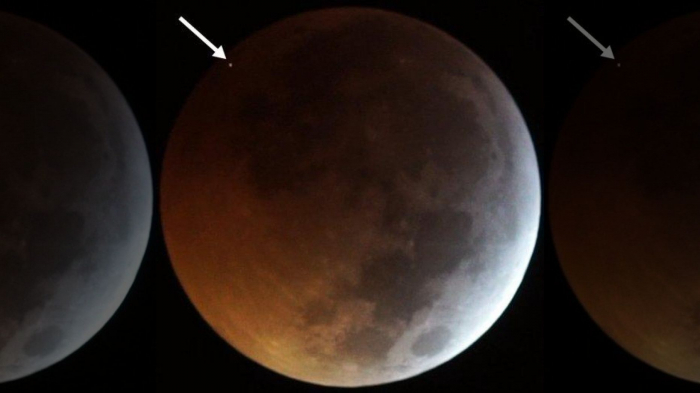Seconds after the total phase of that night's lunar eclipse began, a meteorite slammed into the moon's surface, causing a brief but bright flash of light visible to amateur astronomers across the Northern Hemisphere. Professional astronomers were watching too — and now, after months of studying impact footage taken by a fleet of eight telescopes in southern Spain, a team of researchers thinks they know just how hard the moon got smacked, and what did the smacking.
According to a new study published April 30 in the journal Monthly Notice of the Royal Astronomical Society, the object that hit the moon on January 21 was likely a rogue meteoroid measuring just 1 to 2 feet in diameter (30 to 60 centimeters) and traveling at a staggering 38,000 mph (61,000 km/h). This wee, speedy rock likely created a fresh lunar crater measuring some 50 feet (15 meters) across.
The team reached these estimates after studying the brief impact flash — which lasted only 0.28 seconds — with the Moon Impacts Detection and Analysis System, or MIDAS telescopes. By studying the flash in several different wavelengths of light, the researchers estimated the impact's temperature to be about 10,000 degrees Fahrenheit (5,400 degrees Celsius), roughly the same temperature as the surface of the s un .
Based on the temperature and duration of the flash, the team then calculated the speed of the impactor, its size and weight (about 100 lbs. or 45 kilograms) and the size of the crater it created. The scientists also estimated that the energy of the blast was equivalent to detonating about 1.65 tons of TNT (1500 kg) on our nearest cosmic neighbor.
These numbers are impressive, but not unusual. According to a 2016 study in the journal Nature, the moon's pocked and cracked surface acquires about 140 new craters measuring at least 33 feet (10 meters) across every year. Because the moon has no atmosphere, even the smallest space rocks can make a significant impact on the lunar surface. Usually, however, conditions are too bright for astronomers to see those impacts.
Catching a lunar impact in the midst of a total lunar eclipse is a rare event for researchers like the MIDAS team, who specialize in studying these frequent if unpredictable events. Better understanding lunar impacts could help safeguard the next wave of astronauts set to return to the moon in the next decade, the researchers wrote in the study.
More about: #LunarEclipse
















































